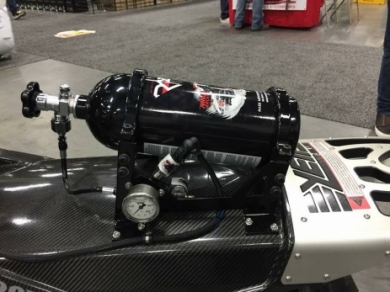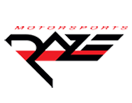
Like a Ninja, our Stage 2 snowbike kit is able to perform efficiently and without hesitation to the highest level of perfection.
Our patented nitrous strategy is the first ever autonomous nitrous system that eliminates human error. Nitrous is extremely violent, sensitive to temperature, and if engaged manually at the wrong time can cause severe immediate engine damage. The kit starts out as the Wingman Kit for its base. This base is worth 11 HP and flawless engine operation in any conditions. We stack the nitrous system with it to create our Ninja Backup Kit. Our solenoid only draws .5 amps to activate. Therefore, there is no need for an auxiliary battery even with kick start bikes.
Watch our interview with Snow Bike World about our Ninja Backup Kit here.
Here is a quick explanation of the strategy and parts included.
The supplied switch that mounts on the clutch side of the handlebar now toggles the ECU into armed or disarmed nitrous mode. Unlike the Wingman kit where the ECU is toggling between race and cruise mode, the ECU with the Ninja Backup Kit is now locked in race mode and the switch is now the nitrous arming switch. When armed, the ECU starts calculating the following before it will activate the nitrous solenoid:
Engine operating Temperature - If the engine operating temperature is to low the ECU will not allow the nitrous to activate. Spraying nitrous into a cold engine could cause stiction. (Seized pistons / 4 point scaring etc..)
Gear Position - Nitrous will NOT activate in 1st gear. Nitrous activation in 1st gear goes instantly to the rev limiter and is useless. Even with a soft-rev limiter strategy in the ECU it risks valve train damage. Therefore, we only activate in 2nd gear and above.
Baro Sensor - This is the black circle you see on top of the ECU in the photo. We use the baro sensor in almost every calibration table. It is extremely important for calculating the amount of oxygen the engine is breathing. The baro sensor also calculates what altitude the rider is at. The nitrous solenoid will not activate under 2000' in altitude. The engine makes way too much power on nitrous at that low elevation to use a 20 HP shot of nitrous without mechanical upgrades. (This setting can be changed in the software, but is not recommended without mechanical upgrades to the engine)
Bottle Pressure - This is by far the most important aspect of our strategy. Most nitrous systems are tuned and jetted for 700psi bottle pressure. When you see us or other professionals using nitrous for drag cars etc., we use bottle heaters to maximize the bottle pressure, then bleed the pressure off right before the race to hit a target bottle pressure number. 15-30 minutes before the race guys have electric blankets wrapped around the bottles to heat them up to 1000psi. Generally speaking, nitrous jets are targeted for 700psi. When they pull up to the line for a burnout they blow it off to bring it down to the 700 they jetted their fuel for. If they have too high of a bottle pressure the engine will be lean. If too low of a pressure engine will be fuel rich. When you see people spraying off their nitrous right before a race it’s not for show. They are bleeding their nitrous bottles down to the correct pressure so the nitrous matches their fuel jetting. The only way to overcome it is to have an ECU monitoring this so it can adjust the fuel table as the bottle pressure changes.
With snow sports, we do not have that luxury of warming bottles up to their maximum pressure. We already don't have a big enough charging system to run lights and electric hand warmer grips - let alone heat a giant aluminum bottle in the middle of the snowy mountains. An advertised 20 HP nitrous jet with a 700 psi bottle will spray 12 HP at 350 psi and 28 HP at 1000psi. The bottle pressure is constantly changing due to volume in the bottle and outside air temp. Even on long pulls you can drop 100psi or more during the run. If the bottle pressure is constantly changing the only way to fuel accurately is to constantly change the fueling table according to the bottle pressure. Or jet it absolutely pig rich so you have a huge safety window, but doing that makes your 20 HP jet of nitrous feel like half or less.
Another way people fuel nitrous systems that we do not agree with, is off the 02 reading. When tuning nitrous based on the 02 reading you are reading what already has happened. Your reading aftermath. With nitrous, if the bottle pressure is way high and you spray a huge hit, by the time the 02 picks up on the lean spike and adds fuel to compensate it could cost you a piston. Therefore, we fuel our nitrous maps based on the bottle pressure so our ECU knows how much fuel to add before it even reaches the intake manifold and as the bottle pressure changes even as your engaged the fuel map dynamically is compensating simultaneously.
Engine RPM - The ECU will not activate the nitrous solenoid unless the engine is above 6000 rpms. The second nitrous is activated, the engine cylinder pressure skyrockets. Nitrous is extremely violent. It’s no different than hitting the oxygen valve to start cutting with your oxy acetylene torch. It determines if you are warming the steel or blitzing a hole right through it. That’s what nitrous does to your combustion event in your cylinder. When it’s activated its game time. If the engine is being lugged down at low rpms and the nitrous is activated the increased cylinder pressure can't drive the piston down because it has too much load on it which can lead to a bent or broken connecting rod. Anybody in the nitrous racing world with manual nitrous kits has experienced this personally or knows somebody that has bent or broke rods by activating nitrous to soon. The only way to safely activate nitrous on...
